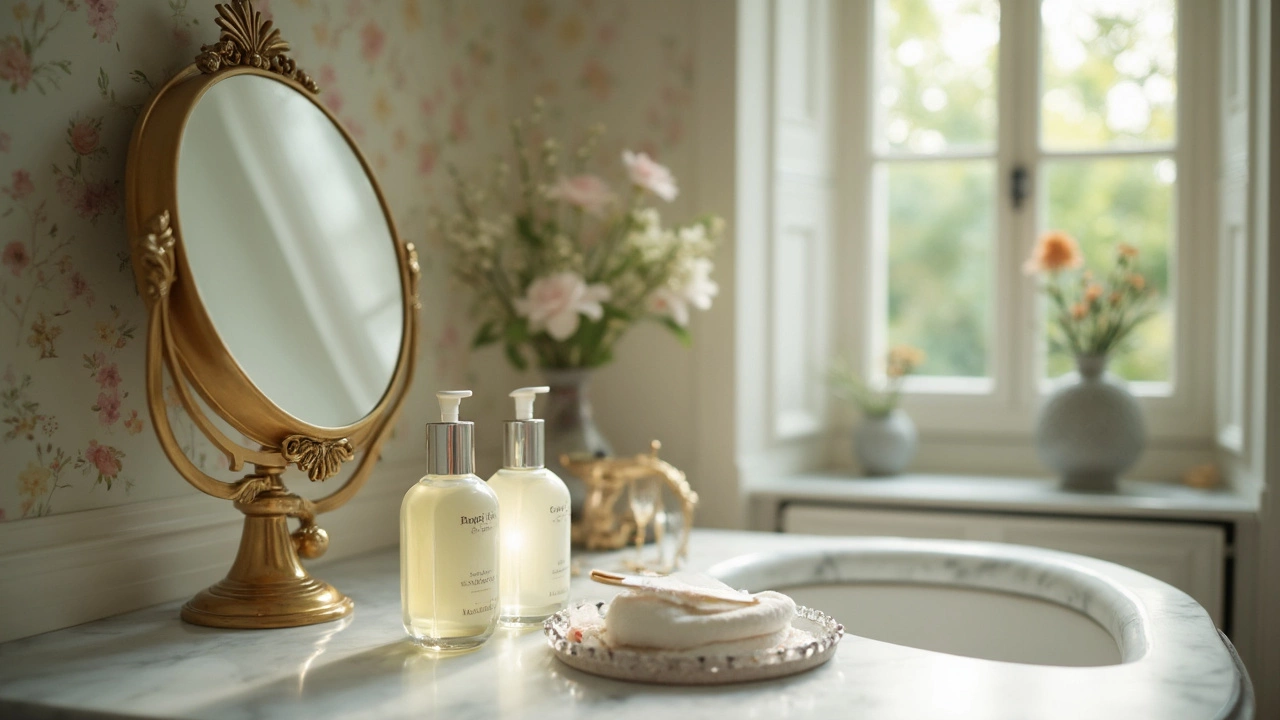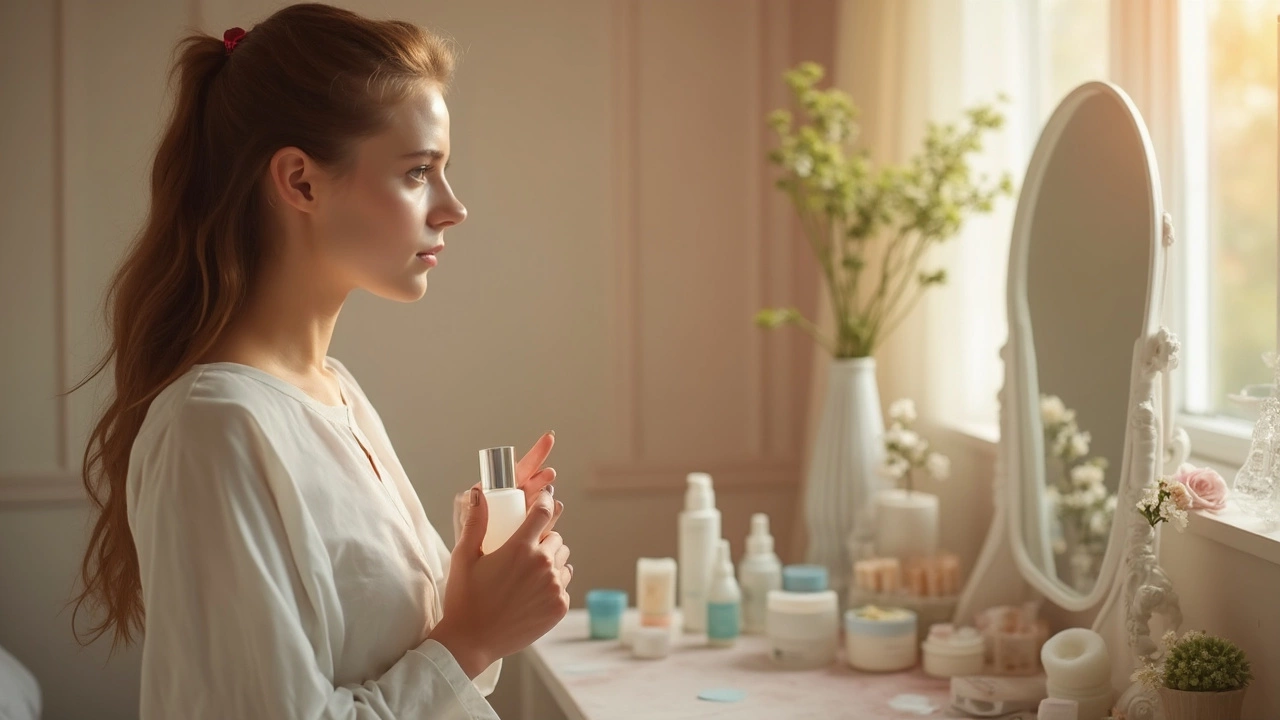Toner or Exfoliator: Which Comes First in Your Skincare Routine?
 Apr, 6 2025
Apr, 6 2025
Ever feel a little mixed up about whether toner or exfoliator should come first in your skincare routine? You're not alone! This little face-off (pun intended) can catch even the skincare savvy off guard. Let's break it down—toner is like the peacekeeper, calming and prepping your skin post-cleansing. It tackles leftover makeup and dirt while balancing your skin's pH.
Exfoliators, on the other hand, are your skin's best friend for ditching dead cells, leaving your face smoother and more radiant. They can come in gentle scrubs or chemical forms, each working magic in its unique way. But here’s the kicker: the order you apply these can impact how effective they are.
The golden rule? Exfoliate first, then tone. Why? By whisking away dead skin cells, exfoliators pave the way for toners to penetrate deeper, enhancing their effectiveness. This sequence helps in minimizing pores and preventing acne without overwhelming your skin.
- Understanding Toner and Its Purpose
- The Role of Exfoliator in Skincare
- Order Matters: Which Comes First?
- Tips for Applying Toner
- How to Exfoliate Correctly
- Common Mistakes to Avoid
Understanding Toner and Its Purpose
Alright, let's chat about toner. It's the unsung hero in our skincare routine, often misunderstood and sometimes skipped. But here's why you might want to reconsider if you're guilty of that skip. After you cleanse, your skin can be left a bit stripped or unbalanced. This is where toner swoops in.
Toners work to restore your skin's natural pH balance. Imagine your skin as a sponge—if it's too alkaline, it struggles to absorb products efficiently. Toners help correct that, ensuring your skin is ready to drink up whatever comes next, like serums or moisturizers. Plus, the right toner can tackle those leftover traces of dirt or makeup that your cleanser might have missed.
There are different types of toners: hydrating, exfoliating, and treatment toners that target specific issues like acne. Modern toners often contain soothing and beneficial ingredients like witch hazel, rose water, or even acids like glycolic or salicylic for mild exfoliation.
Using a toner regularly can improve your skin's texture and appearance. Just apply it with a cotton pad or directly with your hands after cleansing, and let it dry before moving on to the next step. Investing in a good toner that matches your skin type can be key to achieving that glowing look we all love.
The Role of Exfoliator in Skincare
Exfoliation's like giving your skin a fresh start every time. A skincare routine must-have, exfoliators help sweep away dead skin cells that can leave your face looking dull and feeling rough. The magic doesn't end there; they also pave the way for other skincare products to dive deeper into your skin, boosting their effectiveness.
Exfoliators come in two flavors: physical and chemical. The physical ones are your gritty scrubs that mechanically slough off dead skin. They're great for giving instant smoothness, but you gotta be gentle to avoid irritation. On the flip side, chemical exfoliators use alpha hydroxy acids (AHAs) or beta hydroxy acids (BHAs) to dissolve those pesky dead cells. This can be a game-changer for sensitive skin since there's no scrubbing involved.
Why bother with these, you ask? Regular exfoliation can help prevent clogged pores—a major win for anyone battling acne. It also encourages cell turnover, bringing newer, healthier skin to the surface. Plus, it can even out skin tone and improve the appearance of textures like fine lines.
For best results, exfoliate one to three times a week, depending on your skin type. Overdoing it can backfire, leaving your skin distressed and overworked. It's all about balance and knowing what your skin can handle.
- Normal and combination skin: Aim for 2-3 times a week.
- Sensitive skin: Once a week is plenty. Opt for gentle formulations.
- Oily skin: 3 times can be helpful, especially if you're prone to breakouts.
Remember, the goal is to keep your skin feeling fresh, not raw, so always follow up with a hydrating toner and moisturizer to lock in moisture post-exfoliation. Your skin's going to thank you!
Order Matters: Which Comes First?
Okay, so here's the lowdown: the debate of whether toner or exfoliator comes first isn't just a skincare nerd's dilemma; it's actually pretty crucial for getting the most out of your products. Let's get into why this matters.
An exfoliator is meant to slough away dead skin cells. Doing this first clears up the ‘roadblocks’ on your skin, so everything that follows can sink in better— we're talking about maximizing that hydration for that radiant glow. It's like vacuuming before you mop; you just wouldn't swap the order and expect the best results, right?
And here's the scoop on toner: it does a fabulous job prepping your skin. Think balance and extra cleansing. After exfoliating, your skin's ready to absorb what the toner has to offer, minus all the surface gunk. Sounds logical, right?
Some folks swear by exfoliating at night only, just two to three times a week, especially if your skin tends to get moody (a.k.a. sensitive). Our skin rejuvenates while we snooze, so this timing gives it a chance to do its thing without interference.
Remember, if your skincare routine doesn't feel quite right, you might need to adjust how frequently you exfoliate or tone. Patience is key, and hey, skin’s got a mind of its own sometimes, but getting this step right lays a solid foundation for the rest of your routine.

Tips for Applying Toner
Applying toner might seem simple, but doing it right can elevate your skincare routine. Let's get started with a few tips that'll make sure your skin reaps the best benefits.
First off, grab a cotton pad. Pour a small amount of toner on it, but don't drench it. You’re not cleaning a window; your face just needs a gentle swipe. Start in the center of your face, and move outwards. This keeps contaminants from the edges of your skin from spreading inwards.
Consider the toner type you’re using. If it’s one with active ingredients like glycolic acid, it doubles up as a mild exfoliant. If your skin is sensitive, opt for alcohol-free toners to avoid irritation. A little-known fact: the best time to use toner is immediately after cleansing when your skin is still slightly damp. This helps lock in moisture and maximizes absorption.
Toner isn’t just for your face. Don’t forget your neck and décolletage—these areas are just as prone to dryness and need that extra love to stay fresh and smooth.
Finally, make toning a consistent habit in your skincare routine. It’s like how you wouldn't skip brushing your teeth. Regular use can help reduce pore size, make skin feel firmer, and give you a healthier complexion. Need a cheat sheet?
- Use a cotton pad—dab, don’t drench.
- Start from the middle of your face, move outwards.
- Use immediately after cleansing.
- Choose the right toner for your skin type.
- Don’t skip your neck and décolletage.
Equipped with these tips, your toner is your trusted ally in achieving that glowing, fresh face we all chase.
How to Exfoliate Correctly
Alright, let's get into the nitty-gritty of exfoliating. This step can be a real game-changer in your skincare routine, but only if done right. Your skin can get touchy when it comes to those abrasive scrubs, so here's how you keep things smooth, literally.
First off, pick an exfoliator that vibes with your skin type. Got sensitive skin? A gentle chemical exfoliant like glycolic acid might just be your jam. If you're rocking oily skin, a rougher, granular exfoliant could be your thing. When in doubt, do a patch test to avoid any nasty surprises.
Exfoliating once or twice a week is usually golden for most folks, but it's not a one-size-fits-all deal. Keep an eye on how your skin reacts and adjust if needed. Remember, you want to reveal fresh skin, not irritate it.
Now, onto the actual business:
- Start with a clean face. Use a gentle cleanser to wash away any impurities. Rinse well and gently pat your face dry.
- Apply the exfoliator. For chemical types, dab a little on a cotton pad and swipe it over your skin. If it's a physical scrub, take a small amount and massage onto your damp skin in circular motions.
- Keep it around your eyes or broken skin—those areas are more delicate.
- Rinse thoroughly with lukewarm water.
- Finish with moisturizer to lock in the smoothness.
And here's a little wisdom nugget from dermatologist Dr. Emily Winter:
"Exfoliating lets your skin breathe by removing dead skin buildup, but overdoing it is like peeling an onion—take off too much and you end up with tears."
Lastly, to give you an idea of what folks are typically doing, check out this quick overview:
| Skin Type | Recommended Exfoliator |
|---|---|
| Normal | Glycolic acid |
| Oily | Salicylic acid |
| Dry | Lactic acid |
| Sensitive | Enzyme-based |
So, go forth and exfoliate, knowing you've got the know-how to do it right! Your skin's gonna thank you for it.
Common Mistakes to Avoid
Oh, the land of common skincare blunders! It’s easy to slip up, so let’s chat about some goofs to dodge when it comes to your skincare routine.
First up, over-exfoliating. More isn't always better, especially with exfoliators. Stripping your skin of its natural oils can kickstart a rebellion from your face leading to irritation or breakouts. Stick to exfoliating 2-3 times a week, tops.
"Exfoliation is key, but overdoing it can lead to a compromised skin barrier," warns renowned dermatologist Dr. Jane Parker.
Another common slip is skipping the toner after exfoliation. Toners help reset the skin, prepping it for serums and moisturizers that follow. Missing this step is like cooking pasta without salt—possible but not optimal!
Watch out for ingredient clashes too. Pairing harsh exfoliators with potent toners can spell disaster. Imagine mixing a spicy dish with a sour lemonade—sometimes it’s just too much for your taste buds, and it’s the same for your skin!
- Avoid using exfoliators with high concentrations of acids daily. Balance is key.
- After exfoliation, soothe your skin with a hydrating toner, especially if you have sensitive skin.
- Don’t skip your sunscreen post-exfoliation. Your skin becomes more susceptible to sun damage.
So, keep a keen eye on those labels and give your skin the friendly care it deserves. A little attention to detail can make all the difference.
